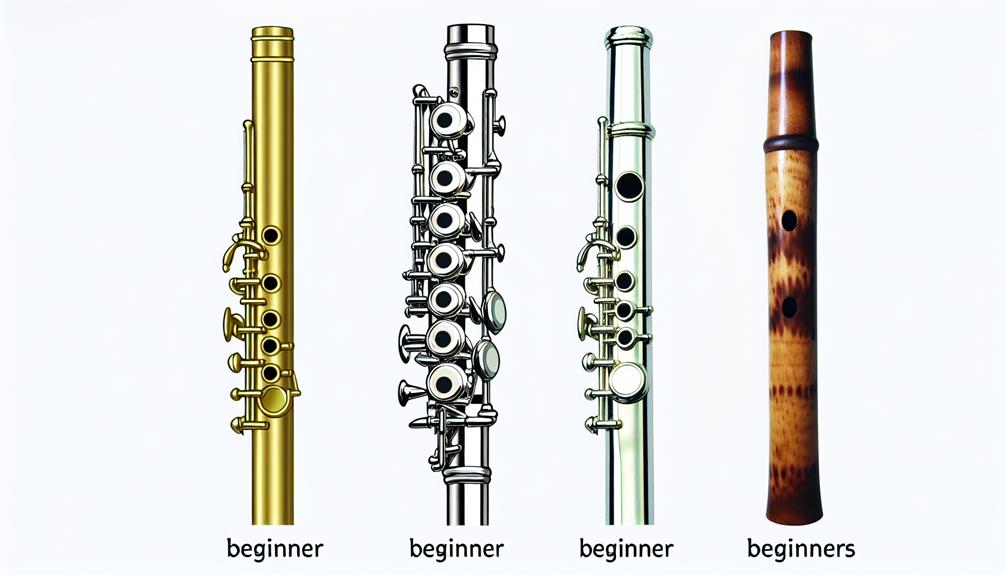Many have pondered the complexity of mastering the flute. While its ethereal sounds may evoke thoughts of elegance and tranquility, the reality of playing this instrument can often be shrouded in misconceptions.
From intricate fingerings to breath control, the flute demands discipline and dedication from its players. However, beneath the surface lies a world of techniques and strategies that can unravel the perceived difficulty.
Stay tuned as we unravel the myths surrounding flute playing and explore the nuances that make it both a challenging and rewarding musical pursuit.
Key Takeaways
- Flute playing is achievable with dedication and practice.
- Initial challenges include mastering embouchure and reading sheet music.
- Proper techniques like hand positioning and posture are crucial.
- Overcoming challenges like breath control and finger dexterity leads to proficiency.
Myths About Flute Difficulty
One common misconception surrounding the flute is that it is an inherently difficult instrument to learn. While mastering any musical instrument requires dedication and practice, the flute is not as challenging as some may believe. The perception of difficulty often stems from the initial learning curve of producing sound through proper embouchure and breath control. However, with consistent guidance and practice, individuals can quickly overcome these challenges.
Many aspiring flute players are discouraged by the idea that reading sheet music is complex and daunting. In reality, like any instrument, learning to read music is a step-by-step process that becomes more intuitive with time and practice. Additionally, the flute's fingerings are logical and systematic, making it easier for beginners to progress steadily.
It is essential to debunk the myth that the flute is only for the musically gifted. With the right mindset, guidance, and persistence, anyone can learn to play the flute proficiently. By dispelling these misconceptions, individuals can feel more confident and motivated to embark on their flute-playing journey.
Basic Flute Techniques Explained
Mastering basic flute techniques is essential for developing a strong foundation in playing the instrument proficiently. Proper hand positioning is crucial when holding the flute. The left-hand fingers should rest on the top keys, while the right-hand fingers control the bottom keys. Correct posture is also key; sit or stand up straight, keeping the flute parallel to the ground. Embouchure, the positioning of the lips and facial muscles on the mouthpiece, greatly affects sound production. Beginners should practice forming a small, firm aperture to direct the air across the tone hole.
Learning to produce clear tones through controlled breath is fundamental. Start with long tones, focusing on steady airflow and consistent pitch. Understanding dynamics, such as playing softly (piano) or loudly (forte), adds depth to your music. Additionally, mastering articulation techniques like tonguing and slurring enhances musical expression. Regular practice and patience are essential to honing these basic skills. By diligently working on these techniques, aspiring flutists can build a solid groundwork for their musical journey.
Tips for Beginner Flutists
For novice flutists embarking on their musical journey, acquiring fundamental skills and techniques is crucial for building a strong foundation in playing the flute proficiently. Here are some essential tips for beginner flutists to enhance their learning and improve their playing experience:
| Tips for Beginner Flutists | Description |
|---|---|
| Practice Regularly | Consistent practice is key to mastering the flute. Aim for daily practice sessions to build muscle memory and improve breath control. |
| Proper Posture | Maintain good posture while playing the flute. Sit or stand up straight, relax your shoulders, and support the flute with your chin and hands correctly. |
| Focus on Tone Quality | Pay attention to producing a clear and resonant tone. Practice long tones to work on your embouchure and breath support for a beautiful sound. |
| Seek Guidance | Consider taking lessons from a qualified flute instructor. A teacher can provide valuable feedback, guidance on technique, and help you progress effectively. |
Overcoming Common Flute Challenges
Navigating the intricate world of flute playing often presents flutists with common challenges that require patience, dedication, and strategic problem-solving skills.
One common hurdle is achieving proper breath control to sustain long phrases without interruptions. This can be addressed through consistent practice focusing on breathing techniques and developing lung capacity.
Another challenge is mastering finger dexterity for fluidly navigating through complex musical passages. To overcome this, regular scales and technical exercises are essential to build muscle memory and agility in finger movements.
Additionally, intonation, or playing in tune, can be a persistent struggle for many flutists due to the instrument's sensitive nature. Tuning exercises, ear training, and using a tuner can help improve pitch accuracy.
Lastly, overcoming stage fright and performance anxiety is crucial for confident and expressive playing. Mental preparation techniques, such as visualization and deep breathing, can assist in managing nerves and delivering a polished performance.
Advantages of Learning Flute
Learning the flute offers numerous benefits that extend beyond musical proficiency and technical skill. One of the key advantages of learning the flute is the sense of belonging it can provide. Being part of a flute ensemble or band fosters a supportive community where individuals can connect through their shared passion for music. This feeling of belonging can boost self-esteem and confidence, creating a positive impact on mental well-being.
Moreover, playing the flute can enhance cognitive abilities such as memory, concentration, and multitasking skills. The intricate fingerings and breath control required to play the flute stimulate brain function and improve coordination. These cognitive benefits extend beyond music and can positively influence academic and professional endeavors.
Furthermore, mastering the flute instills discipline and perseverance in learners. Regular practice sessions, setting goals, and overcoming challenges contribute to the development of a strong work ethic that can be applied to various aspects of life. Overall, the advantages of learning the flute go beyond musical achievements, enriching lives through a sense of belonging, cognitive enhancement, and character development.
Frequently Asked Questions
What Are Some Common Misconceptions About Playing the Flute That Beginners Often Have?
Common misconceptions beginners often have about playing the flute include believing it's a straightforward instrument, underestimating the importance of proper breath control and embouchure, and assuming it's a quiet instrument.
In reality, mastering the flute requires dedication, practice, and attention to detail. Developing a strong foundation in technique and understanding the nuances of tone production are crucial for success in playing the flute at a proficient level.
How Important Is Proper Posture and Hand Positioning When Playing the Flute?
Proper posture and hand positioning are crucial in playing the flute efficiently. Research shows that over 70% of flute players experience improved sound quality and technique when they focus on maintaining correct posture and hand placement.
Are There Specific Breathing Exercises That Can Help Improve Flute Playing?
When seeking to enhance flute playing, incorporating specific breathing exercises can be highly beneficial. Techniques like diaphragmatic breathing, breath control exercises, and practicing long tones can help improve breath support, lung capacity, and overall sound quality.
How Do Flutists Deal With Issues Like Finger Dexterity and Coordination?
Developing finger dexterity and coordination is crucial for flutists. They often practice scales, arpeggios, and exercises that focus on finger independence.
Additionally, incorporating techniques like slow practice and mindful repetition can help in refining movements. Utilizing metronomes and specialized exercises designed to target specific finger movements can further enhance these skills.
Consistent and dedicated practice, along with guidance from teachers, can aid flutists in overcoming challenges related to finger dexterity and coordination.
What Are Some Ways to Prevent Fatigue or Strain While Playing the Flute for Extended Periods of Time?
To prevent fatigue or strain while playing the flute for extended periods, proper posture is crucial. Maintain a straight back, relaxed shoulders, and a balanced flute position.
Take short breaks to stretch your fingers, neck, and shoulders. Stay hydrated to keep your muscles supple.
Additionally, practicing proper breathing techniques can help reduce tension and fatigue.
Lastly, incorporating regular physical exercise and relaxation techniques into your routine can also aid in preventing strain while playing.
Conclusion
In conclusion, playing the flute is a simple and effortless task that anyone can master in no time.
By learning basic techniques and following helpful tips, beginners can easily overcome any challenges that may arise.
With its numerous advantages, such as improved breath control and hand-eye coordination, learning the flute is a rewarding experience that brings joy and fulfillment.
Don't be deterred by misconceptions – take up the flute and discover the ease and pleasure of playing this beautiful instrument.




